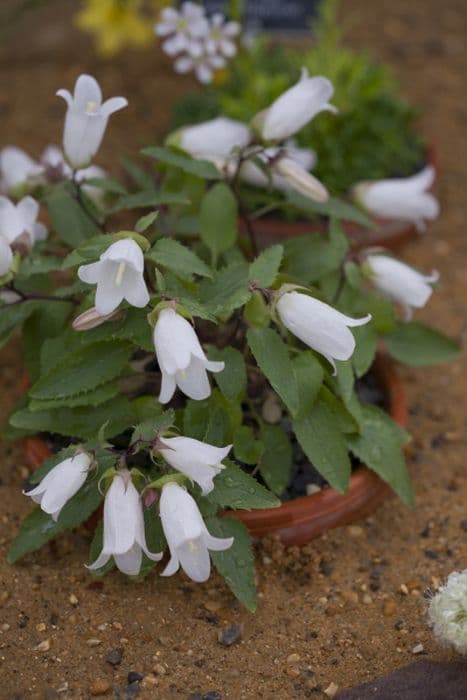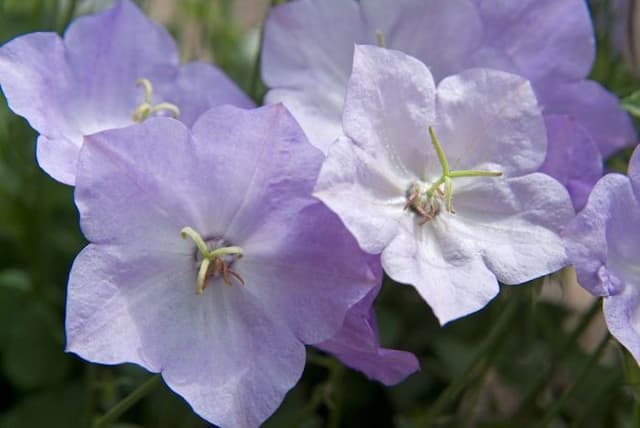Cardinal Flower Lobelia × speciosa 'Hadspen Purple' (PBR)

ABOUT
Lobelia 'Hadspen Purple', commonly known as Hadspen Purple Cardinal Flower, presents a rich and striking display in the garden with its dark purple-red foliage that forms a dense basal clump. Rising above this mound of dark leaves, you'll find elegant, tall spires densely packed with deep purple flowers that boast a tubular shape. The blooms are intricately lipped, and they harmonize beautifully with the leaves, creating a striking contrast that draws the eye. The flowers are not only a visual treat but also a magnet for hummingbirds and butterflies, who are attracted to their vivid color and nectar. The Hadspen Purple Cardinal Flower typically blooms in the summer and can continue bringing vivid hues to the garden until early fall, providing a long season of interest.
About this plant
 Names
NamesFamily
Campanulaceae.
Synonyms
Hadspen Purple Lobelia, Hybrid Lobelia, Lobelia 'Hadspen Purple'.
Common names
Lobelia × speciosa 'Hadspen Purple' (PBR)
 Toxicity
ToxicityTo humans
Cardinal flower, a common name for Lobelia × speciosa varieties, contains several alkaloids that can be toxic if ingested in large quantities. It is generally not considered highly toxic to humans, but consumption can lead to symptoms such as nausea, vomiting, diarrhea, coughing, and excessive salivation. In severe cases, more significant symptoms like hypotension (low blood pressure), heart palpitations, and tremors could occur. Contact with the skin can sometimes cause irritation. It is always prudent to avoid ingesting plants that are not meant for consumption and to teach children to do the same.
To pets
Cardinal flower may also be toxic to pets if ingested. The plant contains alkaloids that can cause vomiting, diarrhea, excessive drooling, and other gastrointestinal issues in animals. In more severe cases, ingestion can lead to more serious symptoms such as tremors, seizures, and heart irregularities. If a pet ingests any part of the plant, it is advisable to consult a veterinarian promptly. Pet owners should prevent animals from having access to cardinal flowers and other potentially harmful plants.
 Characteristics
CharacteristicsLife cycle
Perennials
Foliage type
Deciduous
Color of leaves
Green
Flower color
Purple
Height
2 feet 6 inches (0.76 meters)
Spread
2 feet (0.61 meters)
Plant type
Herb
Hardiness zones
6
Native area
North America
Benefits
 General Benefits
General Benefits- Enhances Garden Aesthetics: Lobelia 'Hadspen Purple' offers striking purple flowers that attractively contrast with surrounding green foliage.
- Attracts Pollinators: The vibrant blooms draw in butterflies and hummingbirds, promoting pollination in the garden.
- Versatile Planting Options: This plant can be used in a variety of settings, including borders, containers, and as a striking centerpiece.
- Extended Blooming Period: It has a relatively long flowering season, providing color and interest in the garden from mid-summer to early fall.
- Drought Tolerant: Once established, Lobelia 'Hadspen Purple' has a certain level of drought resistance, making it suitable for areas with water restrictions.
- Low Maintenance: It requires minimal care beyond regular watering and occasional deadheading to promote further blooms.
- Easy to Grow: This hybrid plant is considered easy to cultivate, making it a good choice for both novice and experienced gardeners.
 Medical Properties
Medical PropertiesThis plant is not used for medical purposes.
 Air-purifying Qualities
Air-purifying QualitiesThis plant is not specifically known for air purifying qualities.
 Other Uses
Other Uses- Attracting Beneficial Insects: Lobelia Hadspen Purple can provide a nectar source for beneficial insects like bees and hoverflies, which in turn help with pollination and controlling pests in the garden.
- Hummingbird Garden: Its striking flowers are known to attract hummingbirds, making it a great addition to a hummingbird garden to provide a natural food source for these birds.
- Educational Tool: Botanical and horticultural educators can use Lobelia Hadspen Purple in study programs to teach about hybridization and plant breeding, as it is a hybrid variety.
- Photographic Subjects: The vibrant purple flowers provide an excellent subject for photographers, particularly those interested in macro photography or botanical themes.
- Landscape Design: Due to its distinctive color and form, it can be used as a 'thriller' element in container plantings, adding height and drama to the arrangement.
- Artistic Inspiration: Artists may be inspired by its striking appearance to create botanical illustrations, paintings, or other art forms.
- Erosion Control: When planted in groups, Lobelia Hadspen Purple can help stabilize soil and prevent erosion on slopes due to its root system.
- Garden Border Definition: This plant can be used to create clear and colorful borders within garden beds, pathways, or next to lawns.
- Vegetable Garden Companionship: Planting Lobelia Hadspen Purple close to vegetable patches can help in attracting pollinators to increase the yield of vegetable crops.
- Seasonal Festive Décor: The deep purple blooms can be used for creating natural and seasonal floral arrangements for events and festivities during its blooming season.
Interesting Facts
 Feng Shui
Feng ShuiThe Cardinal Flower is not used in Feng Shui practice.
 Zodiac Sign Compitability
Zodiac Sign CompitabilityThe Cardinal Flower is not used in astrology practice.
 Plant Symbolism
Plant Symbolism- Devotion: The Lobelia, also known as Cardinal Flower, is often associated with devotion due to its intense color and long blooming period.
- Attraction: Cardinal Flower's vibrant hue is said to attract both hummingbirds and humans alike, symbolizing an allure or drawing in of what one desires.
- Healing: Traditionally, Lobelia is associated with medicinal properties and therefore symbolizes healing.
 Water
WaterThe Cardinal Flower should be watered deeply and the soil allowed to partially dry out between waterings, so thorough weekly watering is recommended. Watering should provide approximately 1 inch of water each week, meaning a garden with an area of 10 square feet would require about 6 gallons weekly. The amount of water can be adjusted during periods of high heat or drought, when the plant may need more frequent watering. It's important to avoid overwatering to prevent root rot, so ensure the plant is in well-draining soil.
 Light
LightFor Cardinal Flower, the best lighting condition would be a spot that receives full sun to partial shade. This plant thrives with morning sunlight and some afternoon shade, as intense, direct sunlight in the hottest part of the day might stress the plant, especially in southern climates.
 Temperature
TemperatureCardinal Flowers prefer temperate conditions and can tolerate a range between 60°F and 75°F as ideal growing temperatures. They can survive minimum temperatures just above freezing, around 35°F, and maximum temperatures up to about 90°F, but prolonged exposure to extremes can damage the plant.
 Pruning
PruningPruning Cardinal Flower involves deadheading the spent blooms to promote further flowering and prevent self-seeding if undesired. Cut back the foliage in late fall or early spring to encourage new growth and maintain plant health. This plant benefits from occasional pruning throughout the growing season to shape the plant and remove any damaged or yellowing leaves.
 Cleaning
CleaningAs needed
 Soil
SoilThe Cardinal Flower 'Hadspen Purple' prefers moist, well-draining soil with a slightly acidic to neutral pH of about 6.0 to 7.0. A mix containing peat, compost, and vermiculite or perlite will provide the necessary drainage and nutrient content.
 Repotting
RepottingCardinal Flower 'Hadspen Purple' does not generally require frequent repotting; it should be repotted once it has outgrown its current pot or every 2 to 3 years to refresh the soil.
 Humidity & Misting
Humidity & MistingCardinal Flower 'Hadspen Purple' thrives best in average to high humidity conditions, without being too extreme; maintaining an environment with about 40-60% humidity is suitable.
 Suitable locations
Suitable locationsIndoor
Place 'Hadspen Purple' in bright, indirect light; keep soil moist.
Outdoor
Plant in partial shade, keep soil moist, protect from high winds.
Hardiness zone
4-9 USDA
 Life cycle
Life cycleThe life cycle of Lobelia × speciosa 'Hadspen Purple' begins with seed germination, occurring in warm, moist soil conditions in spring. Once the seedlings emerge and establish, they grow rapidly to form a rosette of basal leaves. Throughout the growing season, the plant develops tall flowering spikes with vibrant purple flowers that attract pollinators and bloom from midsummer to early autumn. After pollination, seeds are produced and dispersed, completing the reproductive cycle. In colder climates, 'Hadspen Purple' acts as a herbaceous perennial, dying back to the ground after frost but re-emerging from its root system in spring. Over time, the plant can be divided and propagated to maintain vigor and produce new plants.
 Propogation
PropogationPropogation time
Early Spring
Propogation: For the Lobelia × speciosa 'Hadspen Purple', also known as Hadspen Purple Cardinal Flower, the most popular method of propagation is through division. Early spring, just as new growth begins, is the ideal time for this process. To propagate by division, carefully dig up the parent plant, ensuring you keep a substantial amount of root with each division. Gently separate the clumps into smaller sections, making sure that each new section has a piece of the crown and several accompanying roots. These sections should then be immediately replanted in moist soil, spaced about 12 inches (approximately 30 centimeters) apart, to give each new plant enough room to grow. Regular watering will help establish the newly planted divisions. It is important to maintain consistently moist soil, especially during the first growing season, to ensure successful establishment of the divisions.









